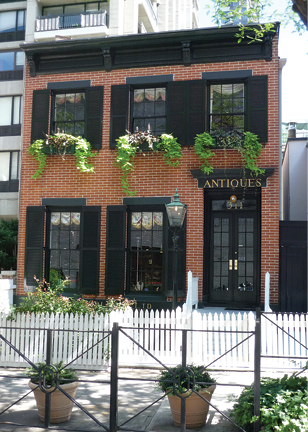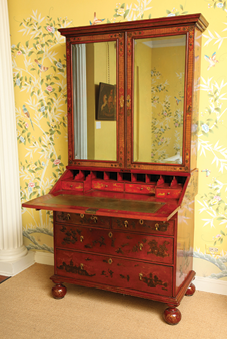


![]()
ONLINE

Fine English Furniture
Editors’ Note
Mark and Diana Jacoby joined Philip Colleck, Ltd. in 1980 and have run it as a family business since 1987. Mark Jacoby earned his B.A. in Art History from Kenyon College, undertook graduate studies at the University of Delaware, and completed the Christie’s Fine Arts Course in London. He served as President of The National Antique & Art Dealers Association of America from 1991 to 1994 and is presently the First Vice-President of their board of directors. Jacoby served as Chairman of the Winter Antiques Show Dealers Committee from 1998 to 2004 and has just been reelected to the committee. For more than 20 years, he has served as a member of the English Furniture Vetting Committees for both the Winter Antiques Show and The International Fine Art & Antique Dealers Show. He was the inaugural Chairman of the English Furniture Vetting Committee for Spring Show NYC.
Company Brief
Established in 1938, Philip Colleck, Ltd. (philipcolleck.com) specializes in very fine 17th, 18th, and early 19th century English furniture and works of art. Located in midtown Manhattan in a pre-Civil War freestanding brick house, their antiques are carefully selected and guaranteed in writing. Philip Colleck, Ltd. also provides professional quality restoration services and additionally has also a long and distinguished history of making fine custom furniture and upholstered pieces. They can also provide professional appraisals of decorative and fine art for insurance, estate, and gift purposes.
How would you best describe the heritage of Philip Colleck?
Philip Colleck was an Englishman who came to this country in 1938. He had visited prior to that and sold antiques to various upscale department stores, and fell in love with New York City and wanted to establish himself here.
He closed the business for World War II and went into British intelligence. He was stationed in Toronto where there were a lot of antique shops so he was able to keep his hands in the trade.
Soon after the war, he came back to New York and established himself on 57th Street where he remained for 30 years. Diana and I joined him in 1980 and worked with him for seven years until he passed away.

Front of the building housing Philip Colleck, Ltd.
at 311 East 58th Street in New York
We decided to continue with the established name and with the focus on his specialty, which is 17th, 18th, and early 19th century fine English furniture.
With a change in taste from traditional to mid-century modern, we have tried to adapt ourselves. Philip Colleck was instrumental in training us in his good taste and refining how we look at things.
Also, in the late ’80s and early ’90s, the spectacular growth of the Irish economy coincided with the appreciation of Irish furniture. The newly wealthy as well as the established wealthy Irish were buying back their heritage. We have always been attracted to Irish furniture and have come to specialize in it somewhat. You see a lot of correlation between the quirky characteristics of Irish furniture and what we regard as classic American furniture. A fair number of Irish cabinetmakers emigrated to the United States in the 18th century.
With all of the antique dealers selling their product, how important is it to build a better understanding of what you offer?
It’s very important. We have dedicated ourselves to being purists. We have over 1,000 reference books in our library that we refer to on a daily basis. Knowledge is king, especially in this business. A little extra knowledge on one piece may lead one to pursue a valuable piece that someone without that knowledge would not know to pursue.
There is great value in being able to educate our clients, to offer whatever we sell with written guarantees of authenticity, and to be able to explain why a piece is authentic and special.
Unlike some of our competitors who have very large showrooms and great volume of inventory, we look at hundreds of items before we choose one to acquire.

A Fine William & Mary Period
Red Japanned Bureau Bookcase with
moulded cornice above two mirror glazed doors
enclosing shelves, decorated in gold with birds,
foliage and diaper pattern, the projecting bureau
with sloping hinged flap enclosing pigeon holes,
four drawers and a well, decorated in
raised gilt with figures and houses in a
landscape, the base with three graduated
drawers and sides similarly decorated, on
turned bun feet. English c.1690
Height: 80 1/2” Width: 39 3/4” Depth: 21 3/4”
Is it difficult to find pieces that qualify for your collection?
When you’re looking to replace a great chair you have just sold, you may come upon a wonderful mirror that you weren’t looking for but that you have to buy because, if you pass it up, you might not ever see it again. It’s a constantly shifting landscape.
When Philip Colleck was alive, three-quarters of our business was through the interior design trade. I have tried to build up our private clientele – collectors – and now our business is about half collectors and half trade. This has been an interesting evolution in that 18th century English furniture is not as popular for decorating as it once was, so we’re concentrating on our private clients and trying to find what they need for their collections.
Is this product primarily for collection or for use?
The wonderful thing about 18th century English furniture is its practicality. This furniture is very well made and has great durability.
At that time, the English Navy was the most powerful in the world; the English empire stretched over two-thirds of the planet. So English craftsmen had the choice of the finest woods available and they had a discerning public who demanded quality for their guineas.
The craftsmen made the finest quality furniture of any country in Europe and I might even extend that to the U.S. It catered to a growing merchant class who could afford fine things.
Since they had the best materials and were building with the finest craftsmanship, these pieces have survived to this day and can be used on a daily basis.
You can pick up an 18th century chair and feel from its weight that it’s a period piece. The timbers used were hundreds of years old when they were harvested. They were first-growth largely mahogany trees from the Caribbean. When this timber first came to England, cabinetmakers didn’t have the proper tools to work it, so they had to develop stronger steel and sharper steel saws and chisels. Once they accomplished this, they started to produce finely carved pieces of furniture.
It’s imminently practical and usually very well scaled – the proportion was very important. The pieces can be quite charming as well.
Are there pieces you acquire that you don’t want to sell?
We buy what we love. We find that we gravitate towards certain pieces.
When you have a shop, it’s important to buy for the shop – you always want to have outstanding examples, be it a bookcase or an armchair.
Sometimes, to acquire a great piece, you have to pay top dollar. You don’t have to sell it right away. It comes into your collection and is much admired, and sometimes, you have to wait for the market to catch up to that purchase price. But if you don’t reach, you won’t have great things.•